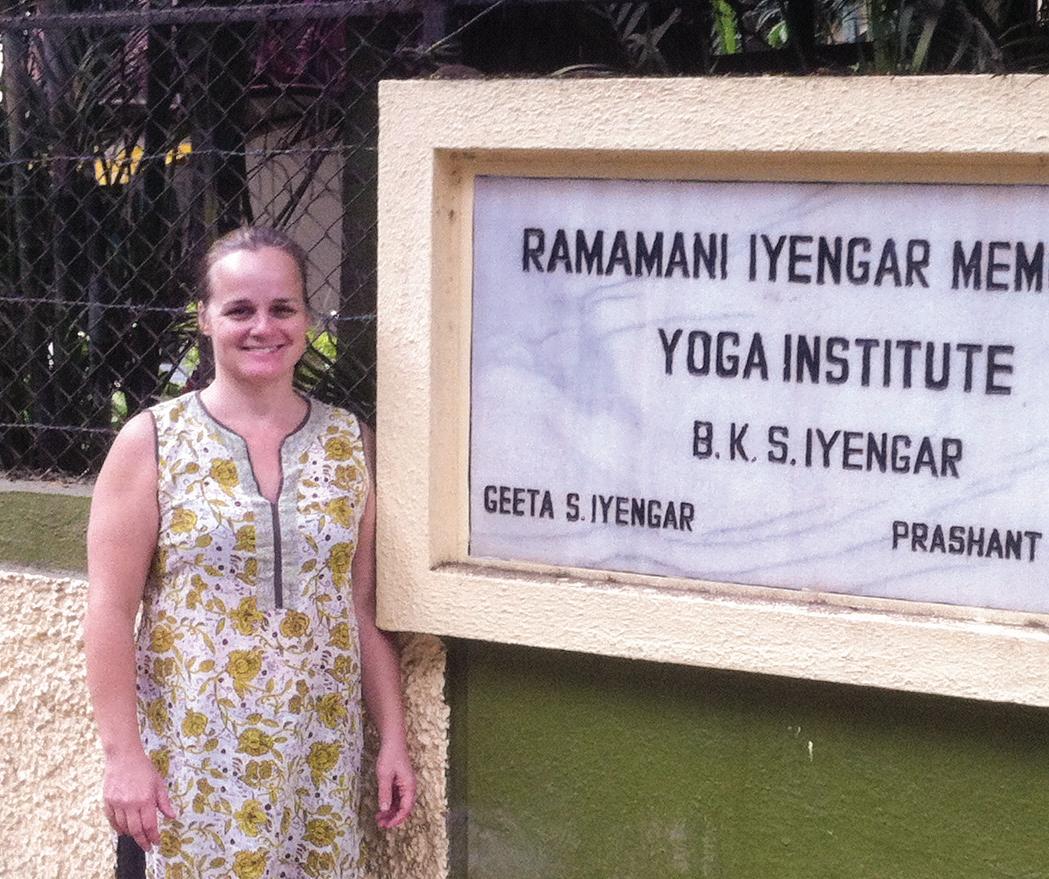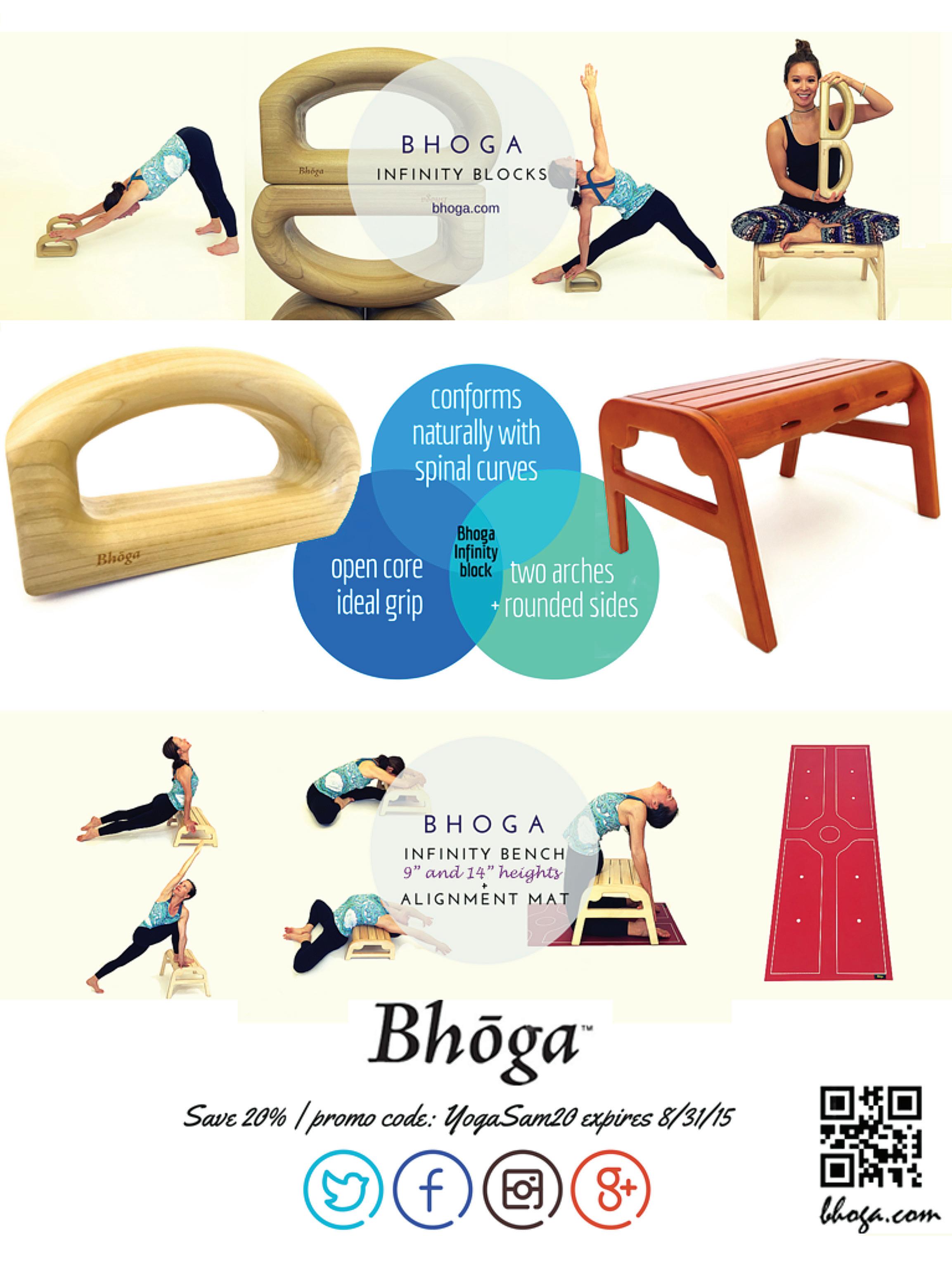
8 minute read
Preparing for Prashant – Anne-Marie Schultz
from Yoga Samachar SS2015
by IYNAUS
can be between vision and body feeling, or other senses, or among the various body-feeling receptors. that someone else can perform on you.
This sensory cooperation forms an active system that you mold with your movements, including your yoga practice, as you learn to feel. Learning to see involves eye movements and the brain. Learning to feel involves spinal pathways, the brain, learning new movements, and change of muscle and connective tissue as we practice.
Advertisement
Maintaining Sensory Teamwork With age, some people lose the teamwork among their senses (an aspect of sensorimotor integration, which is important for people of all ages). By using awareness, we build up the teamwork among our senses. By ignoring one sense or overemphasizing another, a person can lose that teamwork. Most commonly, elders overemphasize vision. Vision is easily available to awareness and seems precise. That’s why we use it in learning asanas such as Utthita Trikonasana. However, depending on vision alone limits balance resilience. As in finance, diversification is a good idea for sensing where your
In an experiment by a Japanese team published in the June 2009 issue of Clinical Rehabilitation, elderly people stood on blocks of
foam rubber and learned to distinguish different hardnesses of foam rubber with their feet. This exercise brought their attention to body feeling. The researchers found that the elders who became more aware of the feeling in their feet improved their balance abilities.
Attention to one’s own body senses has to be an individual practice; it is not a treatment that someone else can perform on you. I would like to see more knowledge and methods become available to those inclined to take personal responsibility for their own resilience in balance, mobility, and general health. In Iyengar Yoga, there is a helpful emphasis on precision in asanas and on svadhyaya, which includes the awareness of body feeling.
Body feeling is an essential part of our balance and mobility system that, when ignored, tends to fade over time. However, awareness and practice can keep it strong and vivid.
Gin McCollum is a theoretical neurobiologist (www.works.bepress.com/ gin_mccollum) who has been practicing yoga, mostly the Iyengar method, for about 24 years.
PREPARING FOR PRASHANT
BY ANNE-MARIE SCHULTZ
Ifirst went to Pune in July 2007. During that trip, my sister and I took the majority
of our classes with Geeta Iyengar. Our first practice session coincided with Prashant’s birthday, so Pandu escorted us to a space right in front of Prashant. What an auspicious start.
Anne-Marie Schultz in front of the institute—Pune, India
Prashant gave a short talk on the importance of learning the subject of yoga. He is a teacher of yoga, not a guru. He teaches that learning the subject of yoga prepares us to be worthy of a guru-sisha relationship. His humility was remarkable. I embraced the opportunity to learn the subject of yoga more deeply while we were there. However, our main contact with Prashant was the “Tuesday Evenings with Prashant” class. We listened to a highly nuanced philosophy lecture while hanging in Rope Sirsasana or coiling over a chair in Dwi Pada Viparita Dandasana or studying ourselves in Utthita Trikonasana.
As a professional philosophy teacher, I didn’t mind the philosophy, but I found the format pedagogically perplexing. Was I supposed to concentrate on the pose or the philosophical point? Should I pay attention to the sequence of postures or the unfolding of the philosophical ideas? As I reflect on that initial exposure to Prashant, I realize that my perplexity resulted from a lack of familiarity with him. Unfortunately, I didn’t take his classes often enough for his teachings to make as much of an impression on me as our five classes a week with Geeta did.
Nonetheless, his ideas worked their way into me. “Prepare yourself” and “The outfit of the mind” and “Create a culture for yog” became permanent parts of my internal discourse about how I prepare myself for yoga practice and for what I hope to achieve both on and off the mat. Prepare yourself, prepare yourself, prepare yourself. Any time I’m in chair Dwi Pada for any length of time, this one comes to my mind and a smile comes to my face. Prashant didn’t say much about exactly what we are preparing ourselves for. At first, I took it like the Boy Scout motto, “Be prepared.” After a couple classes, I sensed that philosophy for Prashant is, much like philosophy was for

Socrates, a protreptic endeavor. This view of philosophy regards the practice as a continual process of engagement, not as a means of acquiring truth. Philosophical instruction aims at engaging students in the process of becoming prepared to be philosophical. Teaching is preparation, not the transmission of knowledge. Not long after that first trip, I asked Eddy Marks if Prashant thought philosophy was anything other than this preparation, and Eddy said, “Yes. But the majority of people are not ready.”
I guess I was not quite ready either. For a variety of personal reasons (moving to Austin, getting a golden retriever puppy named Milo, buying a new house, and marrying my wonderful husband, Jeff), Pune faded into the background of my new life. It was something I had done but not something I was definitely planning on doing again.
Then early in 2012, Jeff decided he wanted to make the trip. I said, “Okay. Let’s do it.” We started to “prepare ourselves.” Imagine my delight when during one of the first classes Prashant said, “I’m going to assume that you are prepared, so now the project is to go further.”
I thought to myself, “Well, maybe he’s just going further anyway.” It is hard to believe we were collectively more prepared. But perhaps our collective studentship had developed. I’m certainly more prepared than I was in 2007. I’ve spent eight more years in practice and study. I’ve completed another level of certification and am studying for yet another one. Not that Prashant himself considers that process any kind of real preparation, but I felt more prepared.
When I heard “prepare yourself” this time, I realized almost immediately that Prashant was preparing us for the practice of YOG in the absence of B.K.S Iyengar. My memories of this 2014 trip are colored with the reality of Guruji’s passing. Almost every evening in June, we saw Guruji outside in the courtyard, beatifically receiving pranams (a respectful greeting made by putting one’s palms together and often touching the feet of the person greeted). We witnessed Guruji’s last days in the practice hall in early July. I remember my experiences in Prashant’s classes in this special light of yoga.
Prashant almost completely defined our class experience. I had Prashant three times a week. Jeff had him four times a week. My mentor, Laurie Blakeney, suggested that I read some of Prashant’s writings and listen to some of his tapes before we went so that I would not waste the first couple of weeks learning how to listen to him. That was excellent advice. From the first class on June 1, I was completely captivated. I experienced quite vividly Prashant’s I started a blog during my 2007 trip and have kept up that regular practice. In 2014, it was quite natural to write every day about Prashant. There was so much to say. The blog developed quite a following while I was there. The fact that I knew people were reading encouraged me to write in more detail. I wanted to share as much of the experience as I could. Its popularity illustrates a bit of the collective yoga mentality that Prashant exhorted us to cultivate. My blog is not just for me. It is beyond me, mine, and in me. Sometimes I wrote about daily life in Pune: the rickshaws, the pigs, the pollution. Other times I wrote about parallels between Prashant’s philosophy and the Ancient Greek philosophy I study professionally. Sometimes I tried to describe class. Other times I tried to capture a few important points and write a bit about them.
Here’s a post from our third day there:
1. “You may think that what I am talking about is complicated.
You are complicated. My teachings are not.”
We are complicated because we are distracted by what is not important, or not real. When our focus is on essential things, we become simple. Prashant’s teachings aim to take us there, but because we are complicated, we do not recognize the simplicity of seeing the seer.
2. “Cultivate the difference between sensitivity and literacy.”
From a yoga perspective, we have to do more than be sensitive to what is going on within ourselves. We have to develop the capacity to know why yoga works. We must know how the various techniques and poses have the effects that they do. We must learn to read and interpret the text of the body.
3. “You must become a student of the master inside of you.”
That is the real teaching of yoga. Don’t look for the spiritual master to be outside. You already know enough to be your own teacher. What timely advice for those who are here looking for some glimpse of the master.
4. “99.9 percent of yoga students who come here are heading toward disappointment.”
While this claim seems harsh, it is probably true. Disappointment comes because we work only with the physical body. Therefore, “can’t do” is a major problem. We have to cultivate the resources to approach the practice differently. In a sense, we need to practice detachment, the second wing, while we can still do. If we wait until we “can’t do” to start cultivating those other aspects of practice, it will be too late.
5. We have to move from pose to asana and beyond asana to yogasana.
Yoga is citta vrtti nirodha. We have to know the mindset that we are looking for. Prashant also mentioned the Bhagavad Gita to help us understand this aim (Book 2, 14, 18). We have to









